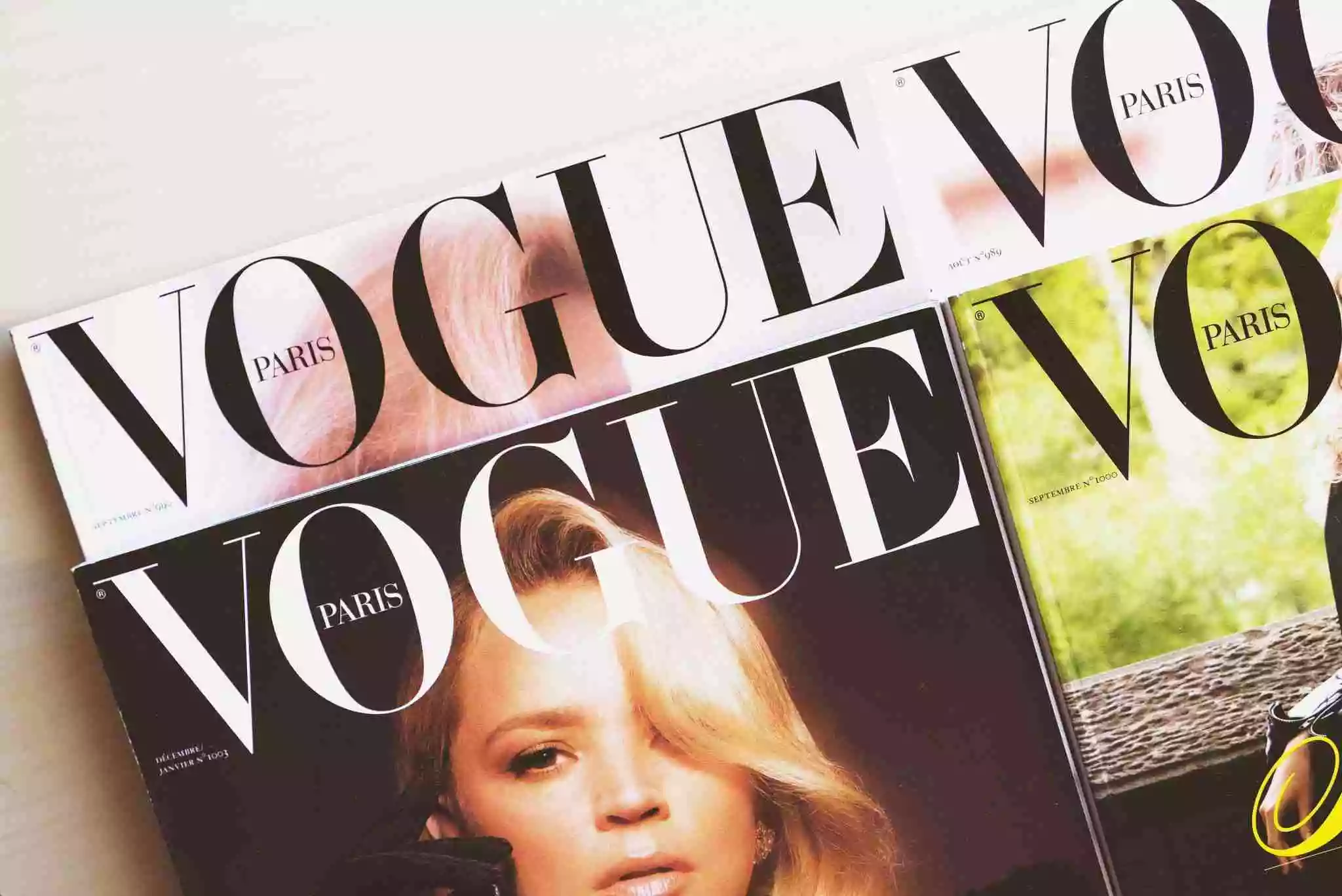Vogue aims to celebrate “the ceremonial side of life”.
Table of Contents
Why Vogue?
Are you fond of fashion and lifestyle content? If yes, then, you are likely to be aware of Vogue. Vogue is one of the notable online fashion magazines with a cult following and stable and distributed revenue streams.
Why we picked Vogue? The publisher that started as a social gazette in the late 19th century, has now become a top lifestyle magazine today. We aren’t charmed by the sight of fashion on the website, but by the unique growth strategies.
Here are a few facts that surprised us and made us curious at the same time:
- Vogue magazine made its first appearance on December 17, 1892, and priced at 10 cents. Arthur Baldwin Turnure introduced the weekly magazine in New York. Now you can get an idea of how long they have been in the publishing industry, surviving several economic downturns and the Great Depression. And as of today, Vogue has 20+ international editions.
- At present, the Vogue brand receives more than 95M+ unique visitors every month. Want to know their social media reach? The publisher has 118.7M+ social media followers according to Conde Nast, the parent company (Src). Besides, check the graph below to know about social media contribution to their traffic.
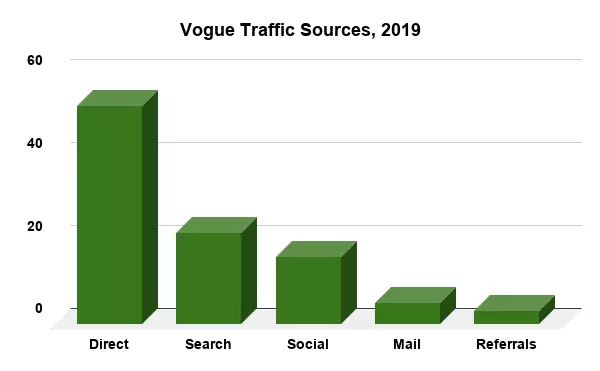
So, here’s a little peek at what you can expect from this case study:
- Traits of Vogue – what they did to acquire traffic and how they turned the traffic into daily users,
- How Vogue differentiated itself from other successful digital publishers, and
- Successful marketing and advertising strategies.
How It All Started?
It was 1995 when Conde Nast launched the digital version of Vogue (vogue.co.uk) (Src). Just a handful of people worked to leverage the then-nascent web to gain readers. Although the dot com version of American Vogue was also available, it existed in Style.com, a fashion website of Conde Nast launched in 2000.
As you could imagine, there was not much traffic and revenue in the early days. Vogue.co.uk was just another new site on the Internet trying to get readers and reach new subscribers.
It is Anna Wintour who has given an innovative look to Vogue, reshaped the era of stylistic ideals and helped the brand to expand their portfolios into several regions.
Where Are They Today?
Since its launch, Vogue has been a favorite fashion brand among millennials. The publisher covers fashion from all angles and has immensely grown its fanbase in the last decade. Many of the competitors questioned whether Vogue will be able to stand the test of time. And undoubtedly, the publisher has crushed such doubts. Look at their numbers:
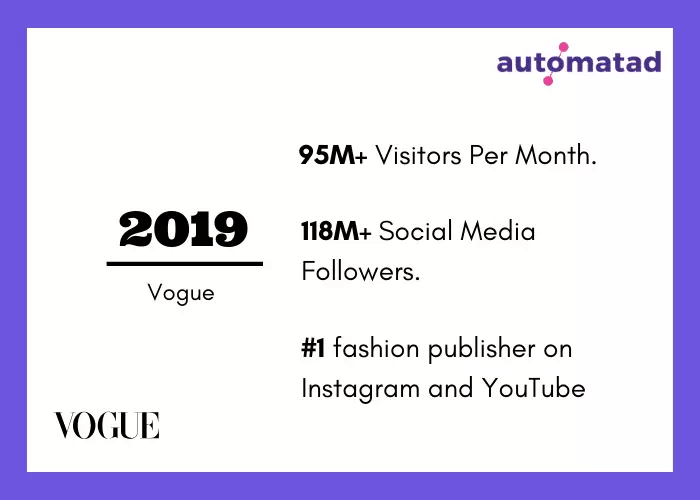
“Vogue is a synonym for fashion consciousness – for style, joie de vivre, and indulgence.”
So, what are the strategies that worked well for Vogue? Let’s dive deep into Vogue’s journey and see how they handled problems and expanded their reach.
Becoming Vogue
Vogue’s Internet Foray
Till 2002
In the late 1990s, the demand for digital content started growing increasingly as the readers started turning to the internet. And, 2.2M+ users were consuming online content in 1994, and the number was expected to double the following year (Src).
So, looking at the trend of the time and to capitalize on online consumers looking for fashion and beauty information about the celebrities, Conde Nast went online with British Vogue in 1995 with vogue.co.uk.
Right from the start, Vogue clearly understood the market it’s going after and knows what sort of content will resonate with the ideal audience. That’s how Vogue managed to bring advertising revenue from luxury brands, even in the early days.
Content Strategy
The publisher wanted to overhaul the digital strategy to better connect with the readers. It had to be authentic and closely align with the brand. The editorial team of Vogue noticed that most readers wanted content that incorporated videos, photos, infographics, etc. So, the team ensured that the site delivers what readers expect – text-rich long-form articles, videos, and photo galleries.
But, the debate that was going on in the team was about monetizing the online content. To adapt to such a challenge, the publisher invested in affiliate marketing – that is pioneered by publishers like BuzzFeed today. But why affiliate?
Affiliate Marketing
In the early 2000s, affiliate marketing was growing rapidly and one of the most popular ways to monetize the content. So, many publishers considered it as an attempt to avoid the revenue pitfalls. This monetization strategy allows publishers to add as many affiliate links as possible to an article and get a percentage of the sale as commission when someone clicks on the click and buys the product.
Since the audience of Vogue was fashion-savvy, they were naturally looking for luxury, beauty, or lifestyle content that can add utility to their lives, the team of Vogue surfaced some of the best-suited products and created a seamless path to purchase.
In fact, it dedicated an entire page “Shop” for marketers. Soon after the marketing became the mainstream for the publisher, Vogue partnered with key advertisers and leveraged the data and audience reach to monetize the content and make the most out of the affiliate marketing.

Brand Diversification
From 2003 – 2008
Teen Vogue
As a sister publication of Vogue, Conde Nast launched Teen Vogue at the behest of Anna Wintour at the beginning of 2003. Although the volume of the magazine was nearly one-third of the average magazine of competitors including Teen People, Elle Girl, and Seventeen, the publisher bet the website, as well as magazine, would be trendy and competitive.
“We’re going to do what we do well, which is fashion, beauty, and style. A lot of other teen magazines are focussed on relationships, boys, and embarrassing moments. That is not our equity.”
– Amy Astley, Editor-in-Chief, Teen Vogue (Src)
So, how did Teen Vogue, focused on teen fashion helped the brand? In the initial days after launch, the publisher ran various contests on teenvogue.com.
During the initial days after launch, the publisher ran various contests/sweepstakes across the site. While some of them were related to refer-a-friend contests, others were somehow unique and interesting. Such as contests that asked teenagers to write and submit 15 dreams or just an original essay or fiction work (Src).
Not just to lure the teenagers, but also to outcast the competition from other publishers including Teen People.
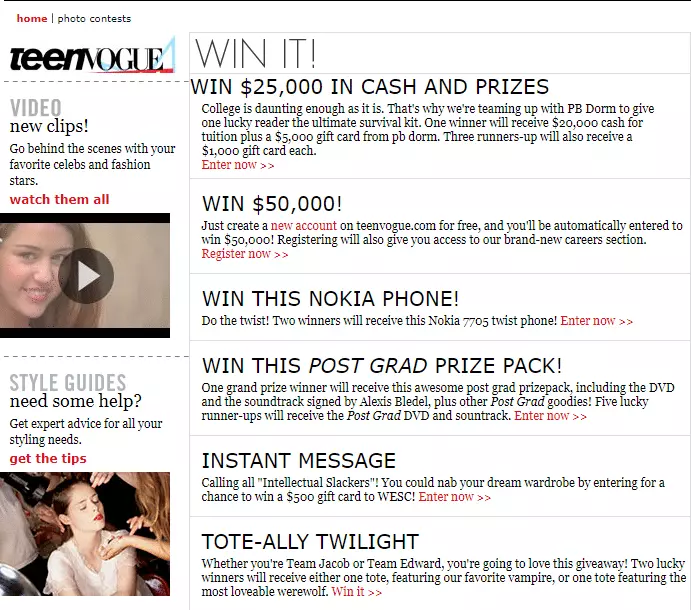
Besides, the sales team reduced the price of print Teen Vogue magazine and made it at $1.50, half of the price of Seventeen (Src). Now, look at the numbers to understand if the strategy worked out or not. According to a report published by the Alliance for Audited Media, more than 2,70,901 copies of the Teen Vogue magazine were sold in August 2005 (Src).
From Print to Plate: Vogue Cafe
Perhaps, opening up a Cafe will be the most surprising move of the Vogue and it would be for any other publisher. In July 2003, the publisher introduced one of the biggest brand extensions into the food and beverage industry with the inauguration of Vogue Cafe in Moscow under the guidance of Elisaveta Yurusheva, a Ukrainian hotelier (Src). But, just the launch doesn’t mean this restaurant concept was successful for the publisher.
However, we aren’t saying that the strategy failed for Vogue. Because if it had failed, we wouldn’t have seen a series of new Vogue cafes in Bangkok, Portugal, and Dubai in recent years. So, that made us find the answers to how come a fashion and beauty publisher maintained a restaurant.
The success of Vogue couldn’t have been possible if it hadn’t partnered with local hoteliers and restaurant owners. The publisher gave extensive brand guidelines to the partners before starting the relationship and drew several conclusions (such as what does Vogue reader in Moscow would like to eat?) to offer relevant food or beverage to people.
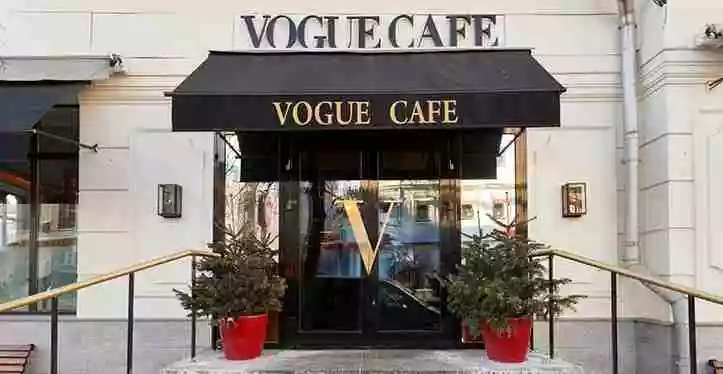
This relevancy and a good and healthy presence of restaurants contributed to the success of Vogue cafes. Besides this, the publisher measured the success of this strategy in terms of staff retention, fully-booked restaurants, a constant stream of returning guests, great reviews, etc.
Vogue Fashion Fund/CFDA
The publisher partnered with CFDA (Council of Fashion Designers of America) in 2003 and launched the Vogue Fashion Fund. The motive of launching this competitive program was to provide a platform for fashion designers to show their talent and get financial help and exposure.
By the end of 2015, the program had granted $4.3 million to more than 30 designers and companies. And, in the same year, the publisher partnered with Amazon and launched the “Fashion Fund” on Amazon. A half-hour season with 10 episodes that is still accessible via Prime Video.
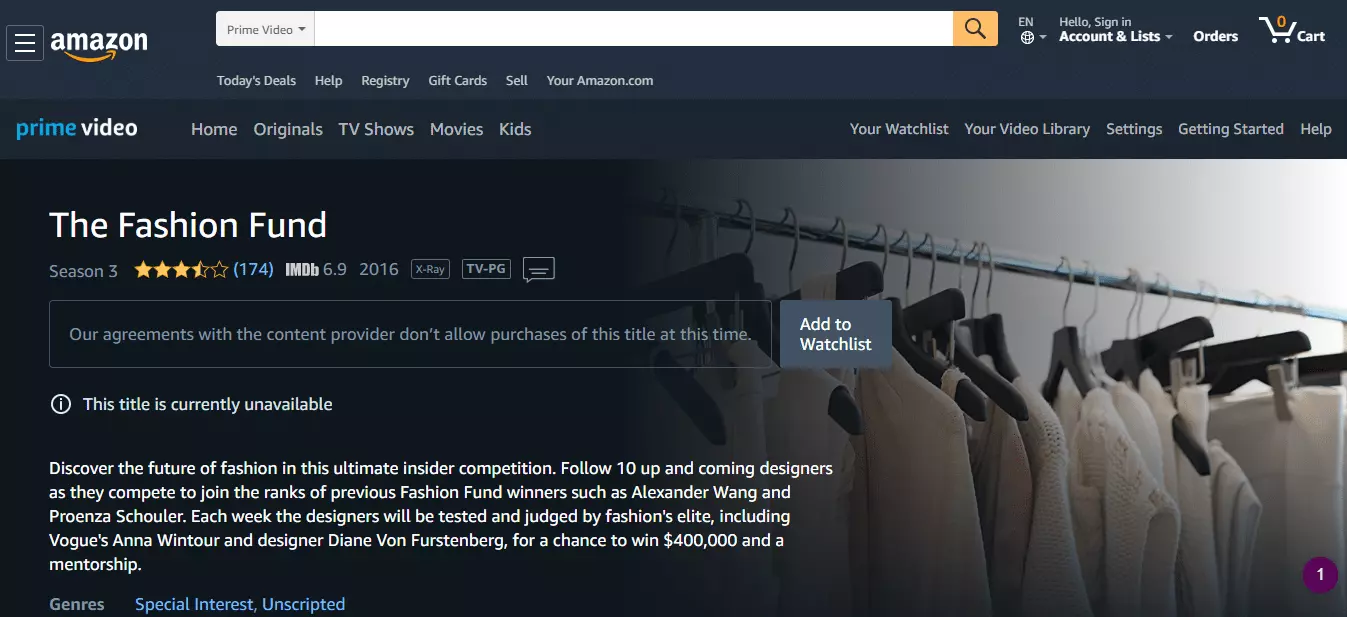
You might be wondering how it is relevant to someone who’s running a media business? To run a media site, you need to source the content from influencers, upcoming fashion designers, and industry veterans. With the Fashion Fund, Vogue circled all of them under its roof.
Vogue Video Channel
Over the past few years, many publishers revamped their video content and monetization strategies. Instead of depending on third-party video platform providers, Vogue started publishing the video content through its owned and operated site, video.vogue.com
Vogue knew the significance of ‘Platform Independence’ back then. The publisher tried many different content formats that aimed at various demographics – from teenagers to millennials. As said, Vogue video channel isn’t dedicated to a particular type of content, it presented the content in several types such as music videos, interviews, tips and tricks, how-to, and many more.

Due to the relevance and accessibility of videos, the publisher garnered 900K+ uniques in one year since the launch. And still attracts 82.17K+ visitors every month .
Cross-Platform Digital Strategy
From 2008 – 2013
Going OTT (Over-the-Top)
2008 was a rough year for print as well as digital publishers. For Vogue, the print magazine saw a decline in ad pages by 9.6%. Side by side, the company was struggling to outpace competitors like Elle and Harper’s Bazaar (Src).
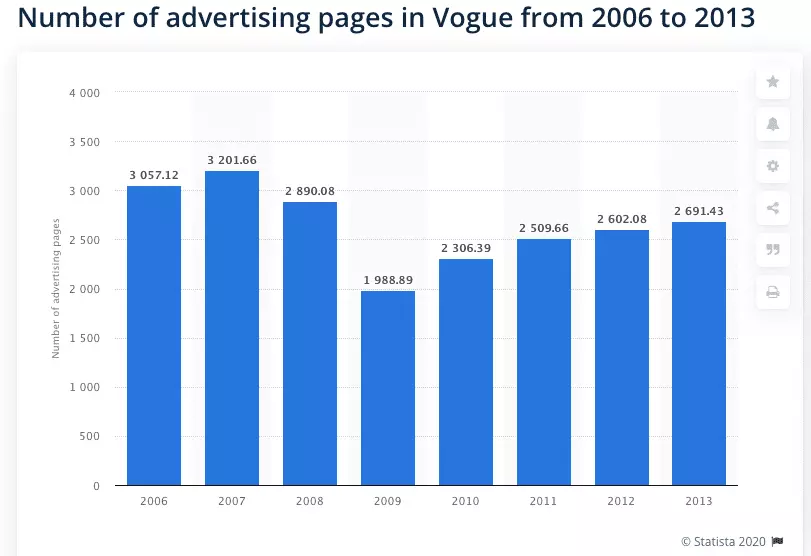
So, to push the audience reach of the magazine and website, the publisher began to expand into new video territory, OTT services for its readers. Since the time period, video-on-demand services have been growing rapidly. Hence, to take advantage of the OTT audience, the publisher introduced a 12-episode web series, Model.Live that gets displayed on EXPRESS.com, Hulu, Veoh, and Tidal TV . The publisher made an impressive 396 million in advertising revenue (total) in 2008 (Src) and attracted over a million unique users (Src).
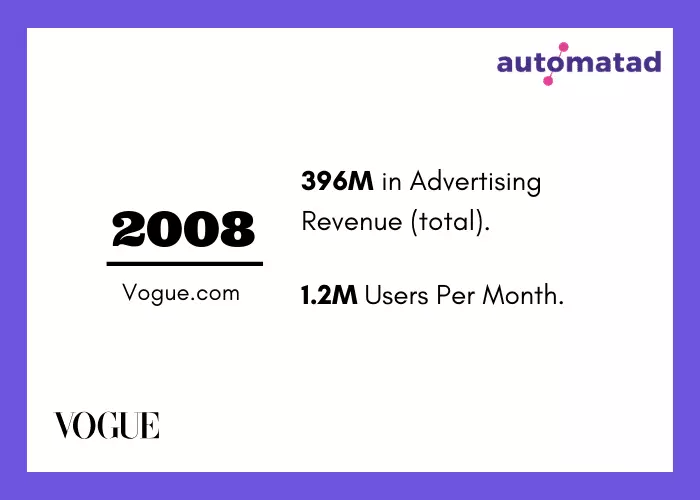
Vogue U.S. Launch
In 2010, the publisher rolled out the new U.S version of Vogue which existed with Style.com till then. It had a clean and user-friendly design and the number of daily posts was increased to 12 as well. The editors and designers aimed to be more nimble while creating content. The newly redesigned website was much faster than the previous one. A team of not less than 22 people was dedicated to the task<!–(Src)->>.
You would be surprised to know that Vougue.com (Vogue U.S) is the largest online property of the publisher though it has been launched more than a decade later.
Looking for reasons? Established brand, audience insights, a proven strategy, and a bigger market.
Voguepedia
Have you ever wondered how the stiletto heels, aviator glasses or swimsuits originated or how Gucci became expensive? Then, let Vogue help you via its encyclopedia. Similar to an encyclopedia, Voguepeida aims at giving the fashion-obsessed users and design students a starting point to learn about the history of the fashion industry or top luxury brands.

The directory basically documented everything and everyone that has ever been mentioned in Vogue.
Similar to Voguepedia, the publisher launched VogueEncyclo that is hosted by Vogue Italia. However, VogueEncyclo allowed the contributors to write content and contribute to the encyclopedia, only Vogue’s staff was allowed to curate and create content for Voguepedia.
Vogue Fashion College
Back in 2011, Vogue opened a fashion college known as the College of Fashion & Design in London. The course and college offered a Diploma course at $19,560 and a 10-week course at $6,600.
But why would a publisher invest in a college course? The step taken by Vogue raised a mixture of skepticism and interest among the competitors. So, in an interview, one of the spokespeople from the college said that the college receives no public funding and the fees are high as the campus not only provided high-end facilities but also networking opportunities with the top brands including Tommy Hilfiger and Victoria Beckham.
“In 20 years, Conde Nast might be known as much for its glossy colleges as it is for glossy magazines.”
Vogue Runway
We have mentioned Style.com a few times before. Didn’t it make you curious about what it is? If yes, then Style.com, a sub-division of Conde Nast, was well-known as a fashion resource and displayed runway photos on the site. It was the Vogue for the American users till 2010 (or the launch of Vogue.com)
But, in September 2015, the parent company merged the 16-year old fashion archive with Vogue and renamed it as Vogue Runway. Vogue Runway existed under Vogue.com.
To promote the ramp walks of Vogue Runway, the publisher partnered with Dash Hudson, an Instagram marketing platform. The LikeShop feature of Dash Hudson helped the publisher to add a link to the profiles’ bio. Once the users clicked on the link, it redirected them to the Instagram feed-like page.
Meanwhile, the LikeShop Analytics which required no additional integrations enabled the publisher’s marketing team to keep a track of the engagement of Vogue Runway.

Automation and Mobile Apps
From 2014 – Till now
Mini Vogue
To stay on top of the publishing industry, readers’ data is one of the most important aspects. During 2015, the publisher found out a new opportunity to attract more visitors by looking at its Analytics data. Knowing that the readers are looking for more kids fashion, Vogue launched a new space – Mini Vogue.
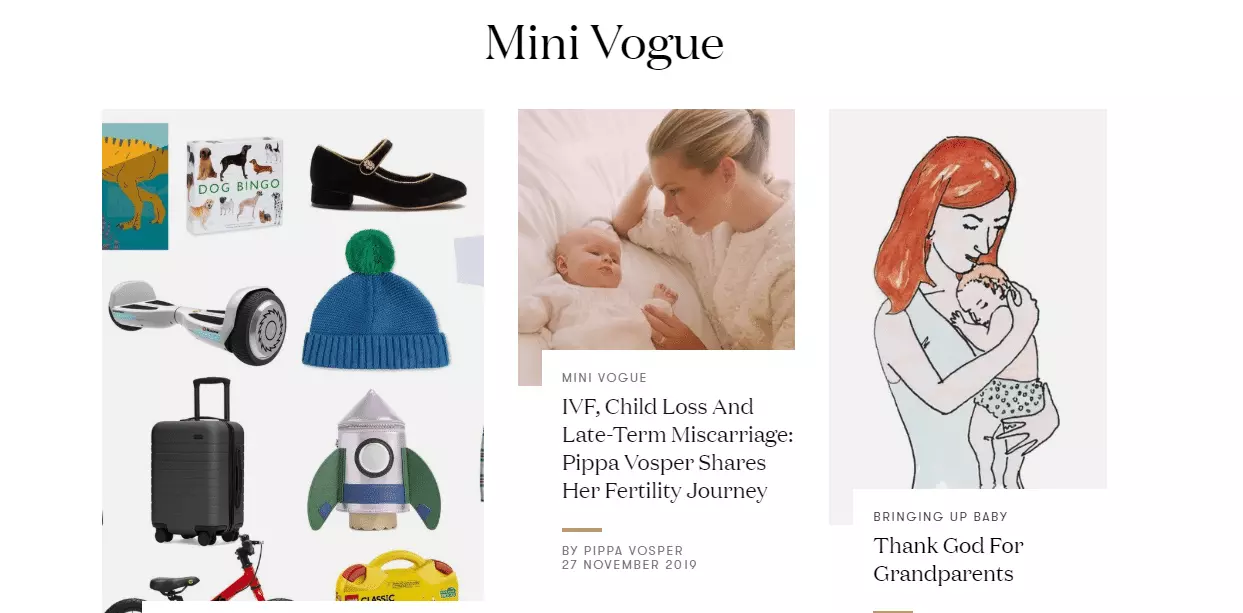
Mini Vogue covered featured content and offered advice and ideas for parents. However, unlike other Vogue’s magazines, there was no print version of Mini Vogue available for the readers. So, to monetize and promote the launch, the publisher partnered with Bonpoint. Besides the sponsorship, Vogue also ran display ads to reach the maximum possible audience. With a team of 55 (Src), the publisher attracted over 10 million users per month in 2016 and accrued a follower base of 17.2 million across Facebook and Instagram (Src).
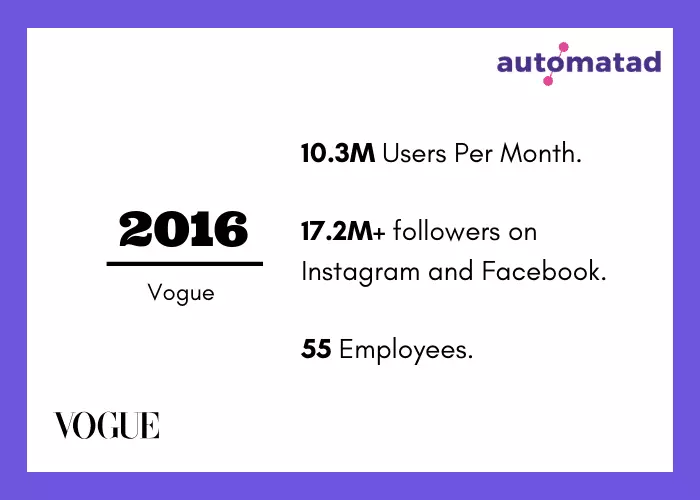
Mobile App Content
By the end of 2015, major competitors of Vogue (Harper’s Bazaar and Elle) were already having an app for the readers. In addition, the publisher was falling behind them in terms of website traffic (Src).
“The Vogue app uses a specifically created platform, conceived to allow fashion photography and shoots come to life, to allow the fashion magazine to offer a multi-sensory experience.”
-Nicholas Coleridge, Managing Director, British Vogue
Though the initiative to mobile app integration has been slow and was accepted by the team, the publisher promised to live up to the consumer’s demand and balance the content with quality and accuracy.
Vogue bots
As per a report published by Statista, more than 1.7 billion users were active on Facebook. And it was clear that most of the people, especially millennials and youngsters accessed Facebook daily. So, to make the content easily accessible for Facebook’s audience base, the publisher introduced a bot for its British Vogue website.
Facebook users were able to receive top stories, runway articles or images or more tailored content on daily-basis directly from Vogue via messenger.
Soon after the launch of the Facebook bot, Vogue became the fashion website to join the WhatsApp messaging app in 2016. Want to know how Vogue promoted the WhatsApp group? Look at the picture below and you’ll understand by yourself:
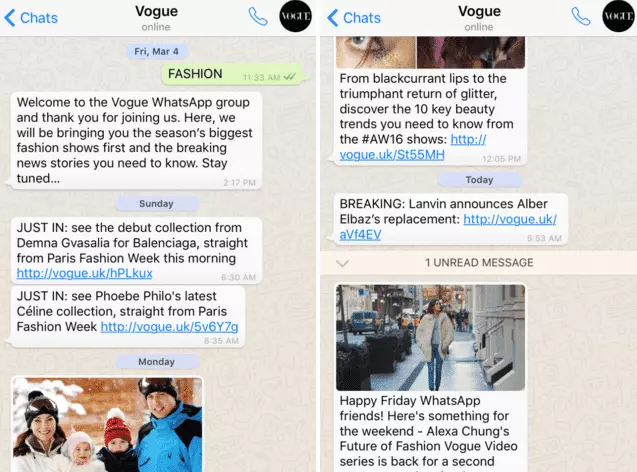
Users can receive the latest news and images from the fashion industry and Vogue Runway directly to their WhatsApp number. Users have to send “Fashion” to Vogue to get all the alerts in the app itself. Moreover, the publisher also promised not to spam the users with updates. So, it limited the text alerts to at most two to three per day. Vogue had monthly pageviews of 57 million at this point.
Next-gen Content Recommendations
Vogue has been growing via several partnerships with Amazon since the digitization of the fashion magazine. In 2016, the publisher brought the partnership with Amazon to the next level by integrating Vogue’s content to Amazon Echo Look, a camera-equipped version of Alexa.
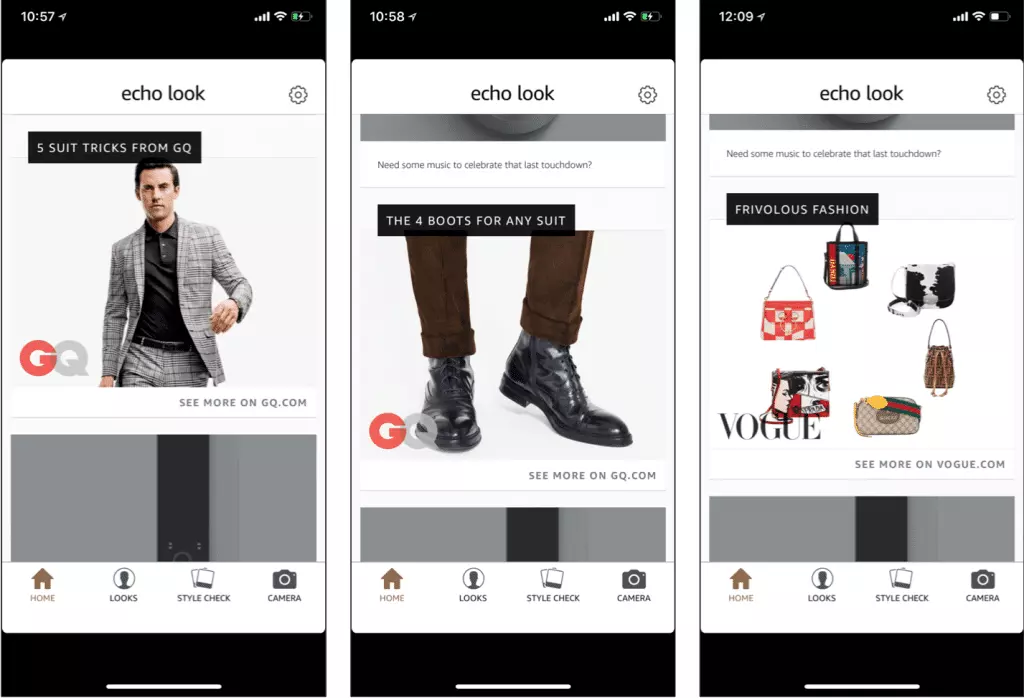
Now, the users can find recommended content via Echo Look. the device allowed users to click a selfie and when they send the selfie to the Echo look app, they get content related fashion, celebrity, beauty, and more from Vogue. In addition to that, if the user buys something via the publisher’s content, Amazon gives a cut of sale to the publisher.
Vogue Newsletters
As the first of its B2B newsletter, the publisher introduced Vogue Business for fashion and luxury industry professionals. In addition to the analysis of fashion industry trends, the newsletter also analyzes and presents content based on global market dynamics such as geopolitics and climate change, how tech and science affect production and sale of products, etc.
“We take a new global, visual, and data-driven approach to journalism.”
-Lauren Indvik, Chief Editor of Vogue Business
Despite being in beta, the newsletter gathered 7,000 subscribers across 29 countries in just six months (Src). Today, Vogue Business isn’t limited to a newsletter sent to the readers via email. It is more than that – a completely dedicated site.
Programmatic Offerings
Vogue is one of the publishers who had flat ad revenue during the beginning of the 2010s when many other women’s fashion and lifestyle magazines had moderate to slow growth in advertising revenue.
The publisher took a long time to step into the advertising era (as they focused on other revenue streams from the start), and in the middle of 2016, while trying to maximize ad revenue, Vogue started to display ads via direct deals.
However, the publisher didn’t pursue display advertising alone. The websites of Vogue also displays video and native advertising alongside the page’s content. So, let’s take a look at Vogue’s advertising model in brief:
Display Advertising
The publisher offered its advertisers to own 100% share of voice and full page-takeover for a given period of time (usually a day) and placed the same creatives (but with different formats – leaderboard, interstitial, etc.) on different ad placements throughout the page. The process which is known as Roadblocking allowed Vogue’s advertising partner to gain brand awareness quickly and effectively.
Besides, the advertising team of Vogue also created a “Reach” or “Extension” product to enable the advertisers to harness the audience reach of Vogue and ensure the visitors are viewing relevant ads via contextual targeting (Src). To do this, the publisher used first-party data segments and created several advertising campaigns around specific events (including relevant content).
“Vogue is not here to burst the bubble; it’s here to sell, sell, sell.”
– Anna Wintour
Header Bidding
Though Vogue was making advertising dollars work, the publisher needed to get a better understanding of what’s happening with the viewable inventories, and fraud-free and brand-safe ad campaigns.
For all these reasons, the publisher replaced the traditional waterfall method and partnered with several (SSPs) such as Index Exchange, Rubicon Project, AOL, etc via a header bidding wrapper to bring more demand and get maximum CPMs for the ad inventories. Also, the parent company, Conde Nast, integrated MOAT and Integral Ad Science to further ensure that the website remains ad-fraud free.
Conclusion
The publisher has first understood what the users need and then used every possible digital channel to attract more audience and revenue. Over its 126 years in the publishing business, Vogue has offered a variety of information with a clear and consistent brand voice. While we haven’t covered all the strategies that worked for Vogue, we pretty much touched the important ones that will be useful to you, a publisher who’s looking to scale the business. Revenue diversification, content distribution channels, and programmatic advertising are the focus areas of Vogue recently and it will likely be. Let us know what you find interesting in this study via comments.


